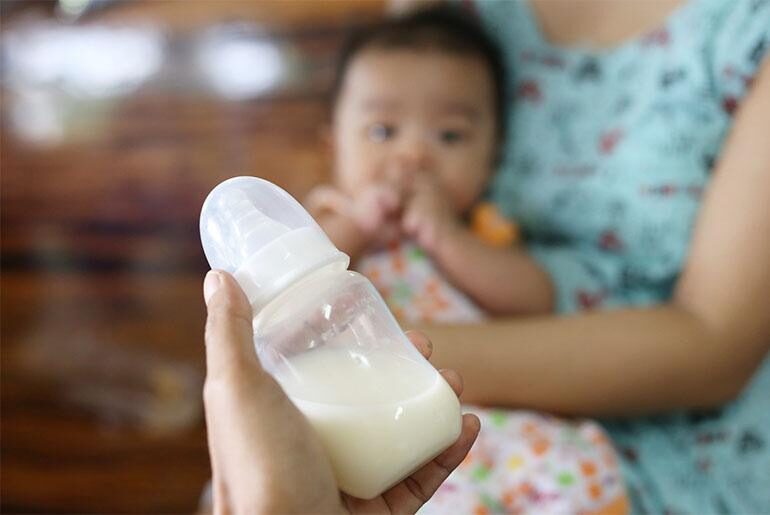Disclaimer: There are affiliate links in this post. At no cost to you, I get commissions for purchases made through these links.
One of the mothers’ concerns is that breast milk does not contain enough fat for their babies. Nutrient deficiencies will affect comprehensive baby development.
So, how to make breast milk fattier? Fortunately, there are many ways to get fattier breast milk. To learn each method in detail and tips to determine if your baby has developed healthily or not, read on in this article!
Ways to Make Your Breast Milk Fattier
Lily Nichols, RDN, states that fat is one of the macronutrients in breast milk that is most sensitive to nutrient intake. The evidence is evident in both the quantity and quality of fat.
Although there are not many scientific reports on this, there is some experimental evidence that fats can be affected. So, if you want to produce fattier breastmilk, try some of the recommended ways below.
1. Consume More Healthy Fats
Based on the above principles, the simplest method to fatten up your breast milk is to absorb fat. Even so, you don’t need to increase the amount of food in each meal. The key here is to improve the quality of nutrient intake.
There have been many different studies surrounding this issue. It is shown that the maternal diet exerts an indirect effect on breast milk through several intertwined metabolic pathways.
In particular, the concentration of fat and water-soluble vitamins such as vitamins A, B6, B12, and C and fatty acids will have a corresponding degree of absorption according to the diet.
So, how do you absorb good fats? Choose foods that include Omega 3 or its equivalent. If you are confused about healthy foods, refer to the following:
- Avocado
- Sardines
- Salmon
- Olive Oil
- Olives
- Trout
- Peanut Butter
- Seeds
- Nuts
Depending on the health status and allergies, each individual will build a suitable menu for the body. You should consult your doctor if you notice any unusual symptoms after eating.

2. Add More Protein In The Daily Diet
Although fat is essential, it is not the only nutrient ensuring a healthy baby. Your body also needs adequate protein.
Its effect is to maintain a regular milk supply and stimulate the production of lactation fluid. It will balance the amount of fat in the milk in the long run.
You can refer to some foods that contain a lot of protein as follows:
- Dairy products
- Lean meats
- Eggs
- Chicken breast
- Fish
- Various types of seeds and nuts
Nuts and seeds are both healthy fats and high in protein. Breastfeeding moms should pay attention to absorbing many of these foods, especially flaxseed.
If you’re a vegetarian, consider drinking a protein shake to ensure you’re getting the total standard amount.
3. Breastfeed Frequently
Not many first-time mothers know that breast milk is a combination of two different liquids, foremilk and hindmilk. By comparison, foremilk serves as a light appetizer. It will help arouse the child’s appetite.
Hindmilk is a liquid containing many nutrients and fats, and it will satisfy the baby’s hunger and provide enough nutrients for the baby to grow up healthy. However, your body needs some time to produce hindmilk.
Irregular breastfeeding schedules or improper breastfeeding are the two leading causes of imbalance between foremilk and hindmilk. In the long run, it leads to many other problems.
The first consequence is a clogged milk duct that impedes the flow. It will cause your breasts to become tight and painful during nursing.
The baby is also affected because the fat content in breastmilk is responsible for satisfying hunger. When he lacks this nutrient, he will drink more and quickly gain weight. Therefore, regular breastfeeding helps to produce fattier breastmilk.

4. Using A Breast Pump
If the baby does not finish suckling completely, combine with pumping immediately afterward to increase milk production. This action also helps to make your breast milk fattier.
A study by the Institute of Medicine showed an increase in milk production of 15% to 40% after using breast pumps.
As you get rid of more and more excess milk, the body will produce new breastmilk with more fat content. Therefore, it would not be unfounded to claim that using a breast pump to empty the breasts has the same effect.
Besides getting help from the devices, you can also express milk by hand. Hold the breast gently and apply pressure on the areola to squeeze any remaining fluid. Alternatively, you can use a warm towel for the same effect.
5. Drain Your Breast
Many mothers assume that they need to breastfeed from both sides in one feeding. In fact, this belief is a trap.
Fat droplets in the liquid stick together and collect in the alveolar walls (milk ducts) when the body produces milk.
When the udder is full, milk gradually moves to the nipple. The thinner liquid, foremilk, will come first, and then the thicker hindmilk with high-fat content.
If the baby is actively suckling and you move them to another nipple, the baby will not be able to absorb the hindmilk. It makes the baby hungry and upset.
An empty breast is a healthy breast. Make sure your baby has suckled on one side before switching to the other. Another scientific study also backs up this view. It suggested that milk’s cell and fat levels increased compared to pre-feed values.
6. Massage and Compress The Breasts
Sometimes, massage and manual stimulation are necessary for better milk flow and passage of hindmilk through the alveoli. This also contributes to making your breast milk fattier.
Before breastfeeding, you can also spend a few minutes massaging to reduce the risk of tightness. This action also helps to unclog the fluid ducts for faster flow.
The steps in the process are straightforward. Simply grasp the breast gently and roll your finger down to the side.
With the movement of your fingers, the milk will be pushed out and break up some of the potential blockages. Stick with the massage in short breaks; you will notice positive changes.

7. Consume Supplements
Taking supplements is also an effective way to make your breast milk thicker. Your OB-GYN can advise the mother to take a daily vitamin B12 supplement.
This vitamin is commonly found in animal products. As a result, vegetarians will have a hard time consuming adequate doses. Likewise, you should consult a nutritionist for Omega 3 supplements if you cannot eat fish.
Babies also need vitamin D to absorb phosphorus and calcium. Vitamin D deficiency is the main cause of rickets and weakens the body.
If the mother is allergic, does not like to eat cereals or cow’s milk, or has limited sun exposure, supplements are the ultimate solution.
One of the most notable functional foods is sunflower lecithin. This supplement can mix the fat content of the milk supply into the more liquid part to reduce the stickiness and blockage of breast milk.
Besides sunflower lecithin, coconut products like milk and oil will also increase the fatty acids in breast milk.
8. Consider The Time Of Day
Depending on the time of day, the fat content in breastmilk changes. According to the Institute of Medicine, over 24 hours, this level ranges from 2g/L.
When you express milk regularly, the liquid will be much fattier. Therefore, the fat content will be higher during the day when you are breastfeeding.
In contrast, milk supply in the morning when you first wake up or come home from work will be lighter and thinner.
The above information is theoretical only. Nursing moms need to keep a diary and record each breastfeeding session. After a while, you will notice when your breasts become fuller. For most mothers, fat levels are highest at night.
If your baby is asleep, but your breasts are still full, consider pumping stored milk in the freezer. You’ll have a more fatty milk supply for long-term use.

9. Try Separating The Breast Milk
With all your knowledge about foremilk and fatty hindmilk, you may be thinking of increasing the amount of fat your baby can consume.
You can use the method of separating two different types of milk. It is suitable for most mothers who pump daily or on occasion. To do this, use the method of the Children’s Hospital of Philadelphia.
You need to start pumping as usual for the first two minutes. When the liquid begins to flow evenly, turn off the machine and pour the solution into an empty container.
This amount will be about ⅓ times the average breastmilk volume you pump. It is foremilk. Then continue pumping until the udder is exhausted.
To compare two liquids, place them side by side. You’ll notice a difference in color, consistency, and density. Finally, you can give your baby a hindmilk bottle to provide enough nutrients for the baby’s development.
10. Consult A Lactation Expert
The last method that you can do is to consult a lactation specialist. They can solve some of the problems or questions when trying to breastfeed.
An early help strengthens your ability to breastfeed. So, consider seeing a specialist as soon as possible.
Why Do Babies Need Fat From Breastmilk?
Mothers, especially those with malnourished children, always look for ways to make their breast milk fattier. The reason is that this nutrient plays a vital role in a child’s development.
Its primary effect is the ability to store excess energy. For children, it promotes growth beyond infancy.
It is a miracle that helps children stay full of energy even after playing for hours. Moreover, healthy fats can also improve vision, brain, and nervous system development comprehensively.
This nutrient is also food for cells and promotes vitamin production in the body. In the long run, it keeps the skin smooth and elastic.
How Much Fat Should Breast Milk Have?
Before looking for a way to fatten up your breast milk, learn about its ingredients.
On average, one ounce of breastmilk contains about 1.2 grams of fat and 19.6 Calories. The fat content of all nutrients, proteins, and vitamins in breastmilk ranges from 3% to 7%. However, this number is not fixed and fluctuates throughout the day. This difference depends on the fullness of the breast and sometimes on the baby’s age.
For a more overview, you can refer to the nutrition facts table below:
Reference: nutritiondata.self.com
| Human Milk Nutrition Facts (per 100 grams) | Amount | % DV |
|---|---|---|
| Calories | 70 | 3% |
| Total Fat | 4.4 g | 7% |
| – Saturated fat | 2 g | 10% |
| – Total Omega-3 fatty acids | 52 mg | 0% |
| – Total Omega-6 fatty acids | 374 mg | 0% |
| Total Carbohydrate | 6.9 g | 2% |
| Protein | 1 g | 2% |
| Cholesterol | 14 mg | 5% |
| Sodium | 17 mg | 1% |
| Potassium | 51 mg | 1% |
| Calcium | 32 mg | 3% |
| Iron | 0 mg | 0% |
| Magnesium | 3 mg | 1% |
| Vitamin A | 212 IU | 4% |
| Vitamin C | 5 mg | 8% |
| Vitamin D | 4 IU | 1% |
| Folate | 5 mcg | 1% |
In fact, you won’t be able to tell how much fat is in breastmilk unless you test them. Even so, your body will produce enough milk to nourish the baby most of the time.
What Affects Fat Content In Breastmilk?
Contrary to popular belief, a mother’s diet will not affect the amount of fat in breastmilk.
However, the amount of food intake can determine the type of fat in her milk. In breast milk, people also divide the fatty content into four different types:
- Saturated fats
- Omega-3 fatty acids
- Polyunsaturated fats
- Monounsaturated fats
When one type increases, another type of fat decreases in content.
It’s not hard to realize that not all fats are healthy. Therefore, the mother should practice a diet to increase the content of beneficial nutrients in the body.
Another factor that determines whether your breast milk is fatty or not is the fullness of the breast.
If the breasts become engorged at the start of a breastfeeding session, the baby will receive watery foremilk. The thicker and more nutritious hindmilk begins to secrete at the end of the feeding.
It also means that the baby will be complete before getting more fat.
Longer feeding intervals mean less fat at the next feed. The reason is that hindmilk attaches more to the milk ducts, and the body produces more foremilk.
How Do You Know If Your Breast Milk Is Fatty Enough?
Indeed, determining whether your milk supply is fatty enough is a thorny issue. You can only observe through some signs.
The first and most obvious sign is that the baby is not gaining enough weight and is skinny. The reason is that fats play an essential role in supporting babies’ proper growth and development.
If you are deficient in nutrients, you will quickly notice a lack of weight for your age. At this point, the best way is to contact your doctor and get the most appropriate advice.
Another sign is that the baby has hypothermia. The lack of nutrients will cause the body to lose heat more quickly because it cannot maintain an average temperature.
At this time, the baby will easily feel cold. The mother should observe and find ways to increase fat in breastmilk.
Lactation Lab also offers a test kit to determine the fat content of your breast milk. If you are interested, try using it for helpful information.
Conclusion
Hopefully, our article helped you understand how to make breast milk fattier.
The key to the method is to increase the intake of healthy fats and prevent a potential imbalance between foremilk and hindmilk.
Each individual will suit a different method. So, do not forget to make an appointment and share with a nutritionist to find the most suitable way for you.
If this article helped you, please share it with other breastfeeding moms. Thanks for reading!



